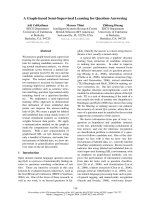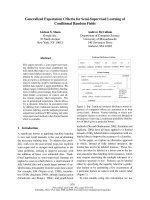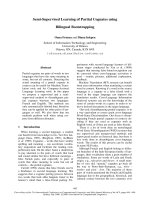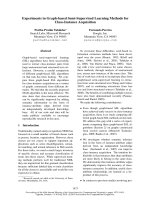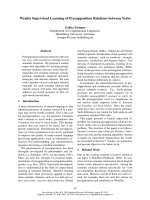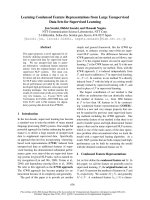Supervised learning cheatsheet
Bạn đang xem bản rút gọn của tài liệu. Xem và tải ngay bản đầy đủ của tài liệu tại đây (835.93 KB, 14 trang )
Star 12,013
Supervised Learning cheatsheet
By Afshine Amidi and Shervine Amidi
Introduction to Supervised Learning
Given a set of data points {x(1) , ..., x(m) } associated to a set of outcomes {y (1) , ..., y (m) }, we want to build a classifier that learns how to predict y
from x.
Type of predictionThe different types of predictive models are summed up in the table below:
Regression
Classification
Outcome
Continuous
Class
Examples
Linear regression
Logistic regression, SVM, Naive Bayes
Type of modelThe different models are summed up in the table below:
Goal
What's learned
Illustration
Examples
Notations and general concepts
HypothesisThe hypothesis is noted hθ and is the model that we choose. For a given input data x(i) the model prediction output is hθ (x(i) ).
Loss functionA loss function is a function L : (z, y) ∈ R × Y ⟼ L(z, y) ∈ R that takes as inputs the predicted value z corresponding to the real
data value y and outputs how different they are. The common loss functions are summed up in the table below:
Least squared error
Logistic loss
Hinge loss
Cross-entropy
1
(y − z)2
2
log(1 + exp(−yz))
max(0, 1 − yz)
−[y log(z) + (1 − y) log(1 − z)]
Linear regression
Logistic regression
SVM
Neural Network
Cost functionThe cost function J is commonly used to assess the performance of a model, and is defined with the loss function L as follows:
m
J(θ) = ∑ L(hθ (x(i) ), y (i) )
i=1
Gradient descentBy noting α
follows:
∈ R the learning rate, the update rule for gradient descent is expressed with the learning rate and the cost function J as
θ
⟵
θ − α∇J(θ)
Remark: Stochastic gradient descent (SGD) is updating the parameter based on each training example, and batch gradient descent is on a batch of
training examples.
LikelihoodThe likelihood of a model L(θ) given parameters θ is used to find the optimal parameters θ through likelihood maximization. We have:
θopt = arg max L(θ)
θ
Remark: in practice, we use the log-likelihood ℓ(θ)
= log(L(θ)) which is easier to optimize.
Newton's algorithmNewton's algorithm is a numerical method that finds θ such that ℓ′ (θ)
θ←θ−
= 0. Its update rule is as follows:
ℓ′ (θ)
ℓ′′ (θ)
Remark: the multidimensional generalization, also known as the Newton-Raphson method, has the following update rule:
−1
θ ← θ − (∇2θ ℓ(θ)) ∇θ ℓ(θ)
Linear models
Linear regression
We assume here that y∣x; θ
∼ N (μ, σ 2 )
Normal equationsBy noting X the design matrix, the value of θ that minimizes the cost function is a closed-form solution such that:
θ = (X T X)−1 X T y
LMS algorithmBy noting α the learning rate, the update rule of the Least Mean Squares (LMS) algorithm for a training set of m data points, which is
also known as the Widrow-Hoff learning rule, is as follows:
m
∀j,
(i)
θj ← θj + α ∑ [y (i) − hθ (x(i) )] xj
i=1
Remark: the update rule is a particular case of the gradient ascent.
LWRLocally Weighted Regression, also known as LWR, is a variant of linear regression that weights each training example in its cost function by
w(i) (x), which is defined with parameter τ ∈ R as:
w(i) (x) = exp (−
(x(i) − x)2
)
2τ 2
Classification and logistic regression
Sigmoid functionThe sigmoid function g , also known as the logistic function, is defined as follows:
∀z ∈ R,
Logistic regressionWe assume here that y∣x; θ
g(z) =
1
∈]0, 1[
1 + e−z
∼ Bernoulli(ϕ). We have the following form:
ϕ = p(y = 1∣x; θ) =
1
= g(θT x)
T
1 + exp(−θ x)
Remark: logistic regressions do not have closed form solutions.
Softmax regressionA softmax regression, also called a multiclass logistic regression, is used to generalize logistic regression when there are more than
2 outcome classes. By convention, we set θK = 0, which makes the Bernoulli parameter ϕi of each class i be such that:
exp(θiT x)
ϕi =
K
∑ exp(θjT x)
j=1
Generalized Linear Models
Exponential familyA class of distributions is said to be in the exponential family if it can be written in terms of a natural parameter, also called the
canonical parameter or link function, η , a sufficient statistic T (y) and a log-partition function a(η) as follows:
p(y; η) = b(y) exp(ηT (y) − a(η))
Remark: we will often have T (y)
one.
= y . Also, exp(−a(η)) can be seen as a normalization parameter that will make sure that the probabilities sum to
The most common exponential distributions are summed up in the following table:
Distribution
η
T (y)
a(η)
b(y)
Bernoulli
log ( 1−ϕϕ )
y
log(1 + exp(η))
1
Gaussian
μ
y
η2
2
Poisson
log(λ)
y
eη
Geometric
log(1 − ϕ)
y
e
log ( 1−e
η )
1
2π
2
exp (− y2 )
1
y!
η
1
Assumptions of GLMsGeneralized Linear Models (GLM) aim at predicting a random variable y as a function of x
3 assumptions:
∈ Rn+1 and rely on the following
(1)
y∣x; θ ∼ ExpFamily(η)
(2)
hθ (x) = E[y∣x; θ]
(3)
η = θT x
Remark: ordinary least squares and logistic regression are special cases of generalized linear models.
Support Vector Machines
The goal of support vector machines is to find the line that maximizes the minimum distance to the line.
Optimal margin classifierThe optimal margin classifier h is such that:
h(x) = sign(wT x − b)
where (w, b)
∈ Rn × R is the solution of the following optimization problem:
1
min ∣∣w∣∣2
2
such that
y (i) (wT x(i) − b) ⩾ 1
Remark: the decision boundary is defined as
wT x − b = 0 .
Hinge lossThe hinge loss is used in the setting of SVMs and is defined as follows:
L(z, y) = [1 − yz]+ = max(0, 1 − yz)
KernelGiven a feature mapping ϕ, we define the kernel K as follows:
K(x, z) = ϕ(x)T ϕ(z)
In practice, the kernel K defined by K(x, z)
= exp (−
∣∣x−z∣∣2
2σ 2
) is called the Gaussian kernel and is commonly used.
Remark: we say that we use the "kernel trick" to compute the cost function using the kernel because we actually don't need to know the explicit
mapping ϕ, which is often very complicated. Instead, only the values K(x, z) are needed.
LagrangianWe define the Lagrangian L(w, b) as follows:
l
L(w, b) = f (w) + ∑ βi hi (w)
i=1
Remark: the coefficients βi are called the Lagrange multipliers.
Generative Learning
A generative model first tries to learn how the data is generated by estimating P (x∣y), which we can then use to estimate P (y∣x)by using Bayes' rule.
Gaussian Discriminant Analysis
SettingThe Gaussian Discriminant Analysis assumes that y and x∣y
(1)
y ∼ Bernoulli(ϕ)
(2)
x∣y = 0 ∼ N (μ0 , Σ)
(3)
x∣y = 1 ∼ N (μ1 , Σ)
= 0 and x∣y = 1 are such that:
EstimationThe following table sums up the estimates that we find when maximizing the likelihood:
μj
ϕ
m
1
∑ 1 (i)
m i=1 {y =1}
m
∑i=1 1{y(i) =j} x(i)
m
∑i=1 1{y(i) =j}
(j = 0, 1)
Σ
m
1
∑ (x(i) − μy(i) )(x(i) − μy(i) )T
m i=1
Naive Bayes
AssumptionThe Naive Bayes model supposes that the features of each data point are all independent:
n
P (x∣y) = P (x1 , x2 , ...∣y) = P (x1 ∣y)P (x2 ∣y)... = ∏ P (xi ∣y)
i=1
SolutionsMaximizing the log-likelihood gives the following solutions:
1
P (y = k) =
× #{j∣y (j) = k}
m
with k
∈ {0, 1} and l ∈ [[1, L]]
(j)
and
P (xi = l∣y = k) =
#{j∣y (j) = k and xi = l}
#{j∣y (j) = k}
Remark: Naive Bayes is widely used for text classification and spam detection.
Tree-based and ensemble methods
These methods can be used for both regression and classification problems.
CARTClassification and Regression Trees (CART), commonly known as decision trees, can be represented as binary trees. They have the advantage to
be very interpretable.
Random forestIt is a tree-based technique that uses a high number of decision trees built out of randomly selected sets of features. Contrary to the
simple decision tree, it is highly uninterpretable but its generally good performance makes it a popular algorithm.
Remark: random forests are a type of ensemble methods.
BoostingThe idea of boosting methods is to combine several weak learners to form a stronger one. The main ones are summed up in the table below:
Adaptive boosting
• High weights are put on errors to improve at the next boosting step
• Known as Adaboost
Gradient boosting
• Weak learners are trained on residuals
• Examples include XGBoost
Other non-parametric approaches
k -nearest neighborsThe k -nearest neighbors algorithm, commonly known as k -NN, is a non-parametric approach where the response of a data point is
determined by the nature of its k neighbors from the training set. It can be used in both classification and regression settings.
Remark: the higher the parameter k , the higher the bias, and the lower the parameter k , the higher the variance.
Learning Theory
Union boundLet A1 , ..., Ak be k events. We have:
P (A1 ∪ ... ∪ Ak ) ⩽ P (A1 ) + ... + P (Ak )
Hoeffding inequalityLet Z1 , .., Zm be m iid variables drawn from a Bernoulli distribution of parameter ϕ. Let ϕ be their sample mean and γ
fixed. We have:
>0
P (∣ϕ −
∣ > γ) ⩽ 2 exp(−2γ 2 m)
ϕ
Remark: this inequality is also known as the Chernoff bound.
Training errorFor a given classifier h, we define the training error
ϵ
(h)
, also known as the empirical risk or empirical error, to be as follows:
ϵ
m
1
(h) =
∑ 1 (i) (i)
m i=1 {h(x )=y }
Probably Approximately Correct (PAC)PAC is a framework under which numerous results on learning theory were proved, and has the following set
of assumptions:
the training and testing sets follow the same distribution
the training examples are drawn independently
ShatteringGiven a set S
= {x(1) , ..., x(d) }, and a set of classifiers H, we say that H shatters S if for any set of labels {y (1) , ..., y (d) }, we have:
∃h ∈ H,
∀i ∈ [[1, d]],
Upper bound theoremLet H be a finite hypothesis class such that ∣H∣
least 1 − δ , we have:
ϵ(
h(x(i) ) = y (i)
= k and let δ and the sample size m be fixed. Then, with probability of at
h
) ⩽ (min ϵ(h)) + 2
h∈H
1
2k
log ( )
2m
δ
VC dimensionThe Vapnik-Chervonenkis (VC) dimension of a given infinite hypothesis class H, noted VC(H) is the size of the largest set that is
shattered by H.
Remark: the VC dimension of H = {set of linear classifiers in 2 dimensions} is 3.
Theorem (Vapnik)Let H be given, with VC(H)
ϵ(
= d and m the number of training examples. With probability at least 1 − δ , we have:
h
) ⩽ (min ϵ(h)) + O (
h∈H
d
m
1
1
log ( ) +
log ( )
m
d
m
δ
)




